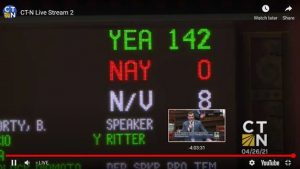After years of advocacy and stakeholder meetings, Connecticut has approved the Long Island Sound Blue Plan!
This completes a near decade-long effort to protect this outstanding resource for generations to come. The unanimous Senate vote very early Friday morning followed unanimous passage on April 26 by the Connecticut House of Representatives. Environment Committee co-chairs Senator Christine Cohen and Representative Joe Gresko led the charge, and Senator Craig Miner and Representative Stephen Harding spoke passionately for the bill on the floor. At the heart of the process was the consideration and inclusion of all voices and interests, reflected in the bi-partisan outcome.
The full Blue Plan, inventories of its uses and resources, and guides for multiple audiences are available on DEEP’s website.
Read more in Governor Lamont’s press release, below.

Governor Lamont Commends Final Legislative Approval of the Long Island Sound Blue Plan
Environmental Organizations and Agencies Applaud Approval of Plan to Guide and Balance the Many Uses of the Sound’s Resources and Spaces
(HARTFORD, CT) – Governor Ned Lamont is applauding the Connecticut State Senate for giving unanimous, final approval early this morning to legislation approving the Long Island Sound Blue Plan in concurrence with the House of Representatives, which approved the plan late last month.
This vote formally places the Blue Plan into effect as a powerful new tool that establishes a framework for identifying and protecting what is cherished about the Sound – its many human uses and underlying ecosystem. It dramatically improves the ability to make good decisions, avoid conflicts and address the challenges of the 21st century while supporting economic growth with the latest and best information.
“This is just another example of what can be done with teamwork and collaboration in Connecticut,” Governor Lamont said. “Environmentalists, businesses, legislators, regulators, academics, scientists, and citizens, all pursuing a common vision that balances the protection of our state’s most vital resource, while ensuring its value as a contributor to Connecticut’s economy and quality of life.”
“Today we see the good that comes through good governance,” Department of Energy and Environmental Protection (DEEP) Commissioner Katie Dykes said. “This plan represents the true power of partnerships and is one of the most significant steps taken in Connecticut’s rich history of leadership in environmental protection and stewardship of natural resources.”
The Blue Plan was called for by the Connecticut General Assembly through Public Act 15-66. Intended to support both water-dependent uses and the marine environment, this pioneering marine spatial planning initiative compiled an inventory of Long Island Sound resources and uses and established siting priorities, standards, and science-based management practices to foster sustainable uses, activities and habitats.
The Blue Plan was prepared by DEEP in partnership with the statutory Blue Plan Advisory Committee, along with extensive input from additional stakeholders and researchers. Built on the best available science and stakeholder expertise, the plan incorporates the contributions of over 2000 individuals including representatives from marine trades, businesses, recreation enthusiasts, state and local public officials, tribes, conservation professionals, and other maritime interests.
Representatives on the Blue Plan Advisory Committee included Connecticut Sea Grant, the electric distribution industry, conservation groups, shellfish/aquaculture industry, coastal municipalities, Connecticut Department of Transportation, Connecticut Department of Agriculture, Connecticut Office of Policy Management, the Siting Council, commercial boating, marine trades, commercial finfish industry, and recreational fishing and hunting communities.
All Blue Plan products, including the final draft plan along with the resource and use inventory and supporting documents and videos, are available at the DEEP website at www.ct.gov/deep/lisblueplan.
“Those who live along Long Island Sound know that it is a balance of commercialism, environmentalism, fishing ,marinas, ferries and shipping but also of recreation, aquatic life and natural beauty and essential salt water,” Senate Chair of the Environment Committee State Senator Christine Cohen said. “The way to balance these competing uses going forward is the intent of the Blue Plan. We shouldn’t be making development or conservation decisions in the Sound on a case-by-case basis, and then looking back at some point in the future and wondering why we didn’t do something differently to prevent exploitation or a missed opportunity there. We need a blueprint, if you will, with resources and parameters to help make those decisions. Thanks to a fantastic, hard-working Blue Plan team, we now have that.”
“Connecticut adopting this state-of-the-art spatial planning tool means our number one asset, Long Island Sound, will have its knowledge available to protect environmental and human uses,” House Chair of the Environment Committee State Representative Joe Gresko said. “It was an honor helping lead passage as thanks to the hundreds of people who created the Blue Plan and to my late friend, Terry Backer, the state’s first Soundkeeper.”
Sylvain De Guise, Director of Connecticut Sea Grant noted that, “the Blue Plan is an unprecedented compilation of spatial information and understanding of the Sound as a whole. It provides user-friendly tools and maps for improved decision-making within the existing regulatory process.”
“This is a dream come true for our beloved Long Island Sound,” Nathan Frohling, director of external affairs for The Nature Conservancy, said. “It is testimony to what we can do when we work together for the common good of people and nature. We salute the leadership in both the House and Senate for getting the job done.”
“This was a remarkable effort at reaching out to all parties and integrating their interests, as shown by the overwhelming bipartisan support through the General Assembly,” Bill Lucey, Long Island Soundkeeper at Save the Sound, said. “It’s clear that all Connecticut residents care about the Sound’s water quality, wildlife, fisheries and sustenance of water-related industries. The Blue Plan is a tool for problem-solvers, plain and simple.”
The legislation is House Joint Resolution 53, Resolution Proposing the Adoption of the Long Island Sound Blue Plan.
